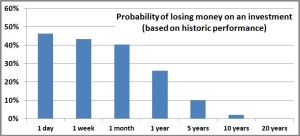
Alberto and Stocky got our MBAs together from the University of Chicago in the 2000s. He was one of the smartest classmates I knew and went to McKinsey after business school, then to private equity, and now to a big data start-up. Plus, his Facebook picture is of him and Milton Friedman, so you know he takes his economics seriously. Alberto grew up in Venezuela and is going to help us with a second installment of International Perspective, by telling us how investing works in Venezuela.
Stocky: Thank you so much for taking the time to educate our readers on how investing works in Venezuela.
Alberto: I’m happy to. After reading this, they might come to appreciate how not-screwed-up things are in their own country.
Stocky: Wow. That’s a certainly enticing. So how do Venezuelans approach investing.
Alberto: Sadly, the biggest goal for most people is to get their money out of Venezuela and into the United States. Once their money is in the US, then they can invest it in bonds, real estate, etc.
Stocky: Wait. What? That doesn’t make sense. Why would they do that?
Alberto: The Venezuelan economy is so screwed up (thanks to decades of socialist economic policies, which were then turbo-charged by Hugo Chavez and his cronies in the last 16 years). There really aren’t capital markets to speak of, so you can’t invest in stocks. Also inflation is about 200% (the government claims 60% but no way it’s that low, even though they stopped publishing any sort of figure on the subject several months ago). Although you can get maybe 15% interest in a savings account (which seems really high at first), you’re losing a ton of money due to inflation. So people want to get out of Venezuelan bolivars and into US dollars.
Stocky: Man. That’s pretty different from maximizing your 401k or investing in index mutual funds, like we do in the US. So how do people go about moving their money to the US.
Alberto: First, Miami is the destination for maybe 90% of all the money leaving Venezuela. It’s good because it’s geographically close, it has a very strong Latin American community, and there are a lot of ex-patriots from Venezuela.
Stocky: Isn’t that where Tony Montana from Scarface lived?
Alberto: Yeah, but he was Cuban, not Venezuelan. Since Venezuelan law doesn’t allow people to take their money out of the country, it leads to a black market. So your average Venezuelan with money will send bolivars to a “money exchanger” who will take that, convert it into US dollars, and then deposit that money into a US bank like Chase or Citi or any other bank like that. It’s all done at the black market exchange rate which is about 700 bolivars to the dollar; although the “official” exchange rate according to the government is 6 bolivars to the dollar.
Stocky: That sounds pretty “cloak and dagger”. Is that safe? I could imagine crazy stories of people getting ripped off with stuff like that.
Alberto: Yeah, sometimes people get ripped off, but these black market transactions have become so common that pretty much everyone knows someone who does this. Maybe it’s your uncle or your dad’s best friend or someone like that who will handle things for you. That’s pretty common.
When you start working with someone, you start small. Maybe $500 worth, or something like that. After you see if they are honest, then you can give them more and more money. Through it all, people just want to get as much money out of the country as possible because the economy is in freefall. So I suppose they’re willing to take on a fair amount of risk. If you tried to move your money and lost it that sucks, but if you keep it in Venezuela you’re pretty much guaranteed that you’ll lose it to hyperinflation.
Stocky: Ouch. Once people get their money to the US, how do they invest it?
Alberto: Mostly it’s either in CDs or bonds, or those who can afford it will buy American real estate.
Stocky: I spend a lot of time talking about asset allocation and how people should invest in stocks and not too much in bonds. It sounds like these people aren’t listening to my advice. Who would do such a thing?
Alberto: Surprisingly, www.thestockyfox.com is not the #1 website in Venezuela, at least not yet. I think there are a couple reasons behind that. First, remember that the goal is getting the money out of a country with hyperinflation. If people can make 2-3% with scant inflation by moving their money to the US, that’s a nice win for them.
Second, most Venezuelans, even most upper-middle class ones, are not that financially literate. Learning the intricacies of investing, asset allocation, the differences between stocks and bonds, etc., just aren’t that high of priorities. So once people get their money to Miami, they just choose a pretty simple investment which is a savings account or bond.
Stocky: After the money is in Miami and invested how do people get it back to Venezuela. After all, isn’t the whole point of investing so you can take money today, let it grow over time, and then spend it on your needs tomorrow?
Alberto: That’s an interesting point. I don’t think most people are giving much thought to bring the money back home. People are waiting to see what’s going to happen to the country. Politically, and therefore economically, Venezuela has been a crazy roller coaster. When Chavez took control in 1999 he implemented a ton of social reforms that turned the economy on its head. When oil prices were high, we could afford to do that, but now that oil prices have come way down, things are pretty bad.
Because of all of that, I think people are just waiting to see what happens to the country. If there is a miracle turnaround like what happened in Colombia or better yet Chile, then people will see a future in Venezuela and bring their money back to spend. However, I’m not optimistic, and if things continue to stay bad, I think people with the means will look to leave the country and join their money in the US.
Stocky: That’s just crazy. What do people do who can’t move their money abroad?
Alberto: It’s really, really sad. If people can’t move their money out of the country, you end up with some really bizarre economic activities. Some people will invest in things like appliances. Literally, it’s not uncommon to buy something like a washing machine with the intent to sell in. Let’s say you buy one for 20,000 bolivars, use it for a couple years, and then because of inflation you can sell it for 50,000. You made money plus you got the use of the appliance for a while. Had you just kept that money in cash, you’d end up with much less. There are active secondary markets for appliances, cars are a big one, really anything that you can buy that is durable.
Stocky: Are you serious? We had a mailbag question from Ally about investing in consumer electronics, and the idea just seemed so crazy to me.
Alberto: You’re right, it is crazy, but that’s the reality in a country where the economy is just strangled by inflation. Consider yourself lucky that you’re from a country where you’re pretty confident that your dollar will buy something very close to a dollar’s worth of stuff next year.
Stocky: You’re painting a pretty grim picture of Venezuela. What do you think the future holds for your home country?
Alberto: It pains me to say that I’m just not confident. Maybe you could have a massive turnaround like what happened to Chile in the 1970s of even Col0mbia in the 2000s, but I think the socialist government is so entrenched, and the magnitude of the brain drain has been too large for things are going to get better any time soon.
You’ll continue to have money flow out of the country as fast as it can go, but even more troubling is that you’ll have the most talented people leave. Back at school there were probably a dozen of us Venezuelans who were getting our MBAs from one of the best schools in the world. None of us went back home because there just aren’t any opportunities. But for Venezuela to succeed it needs people like us to go drive change. It’s a catch-22: change won’t happen without smart and capable leaders, but the country is so screwed up that all those people leave. It’s not a good situation.
Stocky: On that happy note, I want to thank you for sharing how things work in Venezuela with us.
Alberto: Thank you. Venezuela had a lot going for it when I was a child, but unfortunately, the government has thrown a lot of that away, and mortgaged the country in the process. I hope that things do get better, I truly do.
For all my international readers, I plan on doing more of these types of posts that tell us how investing works in different parts of the world. If you would be interested in sharing how it is done in your country, please contact me and we can set something up.











